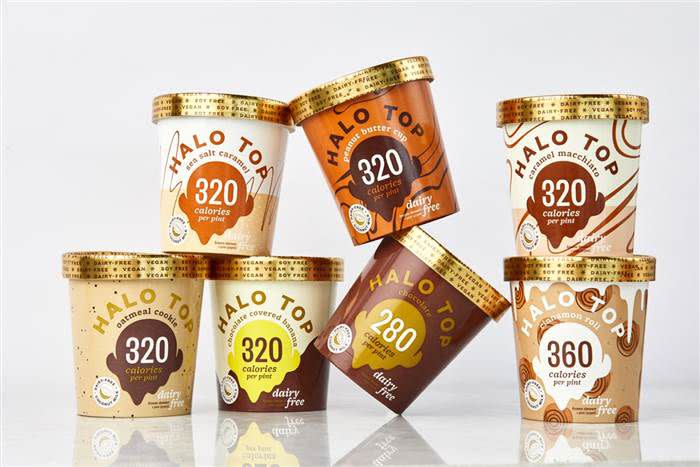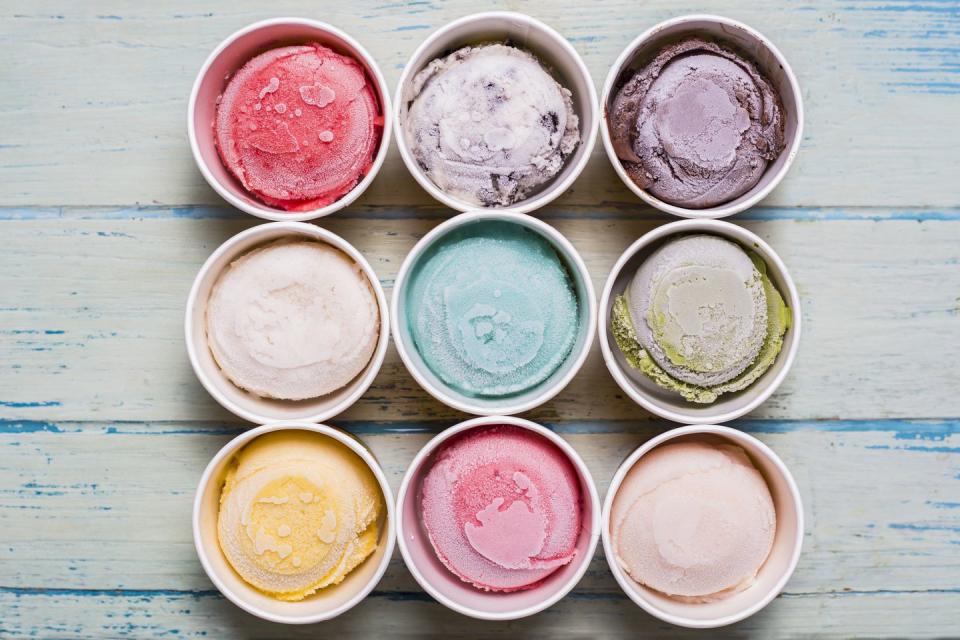Is 'Healthy' Ice Cream Too Good To Be True?

If I met a genie, one of my three wishes would be to have an ice cream I could eat every day forever without it being unhealthy.
If you’ve recently set foot in the frozen goods aisle of a Whole Foods or Tesco recently, however, you’ll know I can probably cancel the genie – 'healthy' ice cream already exists.
And it’s seriously popular, as you can imagine: in the US last year, low-calorie, high protein ice cream brand Halo Top outsold every other kind, including classics like Ben and Jerry’s and Haagen Dazs. And it arrived here in the UK in January.

But just how healthy is this dreamy product?
How much can we eat? Are there any nasty ingredients? And is it such a good idea to healthify one of our favourite treats anyway?
To find out, I spoke to food scientists, ice cream academics and nutritionists. First port of call was Professor Robert 'Bob' Roberts, head of food science and curator of two ice-cream-specific courses at PennState University, whose personal favourite flavour is full-fat dolce de leche or classic vanilla, by the way.
'I’d actually say what you’re talking about is sometimes not even ice cream, it’s more a frozen dessert because they’ve altered the ingredients that much, but I’m a purist,' he says.

Some of the ingredients Professor Roberts is talking about include artificial sweeteners, emulsifiers and stabilisers, all of which help imitate an ice cream-like texture and flavour – because sugar, for instance, does more than just sweeten the tub.
'Sugar is there to depress the freezing point of an ice cream and fat is for structure. They hold the elements of the ice cream together and make sure it freezes properly, so if you’re taking out those ingredients you have to replace them with something else to serve those functions. Something like glycerol is there to depress the freezing point and polydextrose is there to replace the bulk of fat.'
Gylcerol is a syrupy substance and polydextrose is a synthetic form of glucose.
Should we be frightened of these foreign-sounding ingredients in our ice cream?
'From my perspective as a food scientist, there are no ingredients in these products to be wary of,' says Professor Roberts. 'Each of them is functional, most of them are natural and all of them are safe. I am confident in the system: manufacturers can’t put unsafe ingredients into food, especially if they want to call them healthy.'
Ingredients like maltitol – a sugar substitute – and carrageenan – an emulsifier extracted from purple seaweed – also get the seal of approval.
So too does stevia, probably the most popular alternative sweetener, which comes from the stevia plant. It has zero calories and despite its recent surge in popularity, has probably been used since the 1800s. Stevia is regarded by most experts as safe, but some researchers wish we had more evidence.
Professor Roberts is a fan: 'Stevia is fine, stevia is great.' This confidence in stevia is echoed by every expert I speak to, despite its bad rep.
Melanie Loades is a biochemist and founder of the product development company Frog Hop, which specialises in new food and drink. Her favourite flavour ice cream is raspberry ripple, with plenty of ripple.
She agrees that the alternative ingredients in 'healthy' ice cream shouldn’t panic us. I took her through all the ingredients in both Breyers and Halo Top ice creams – two of the more popular brands – and she says not to be alarmed by anything in them.
'If ELLE readers want to know if they can trust these ice cream products, they can. You cannot make claims about being lower in calories or higher in protein without it being quantifiable. So these products have to be really 30 per cent lower in sugar than any decent competition and 20 per cent of the product’s energy has to come from protein for it to be labelled high protein. You cannot make these sorts of claims without proving it.'
One tub of Halo Top vanilla bean flavour ice cream is 280 calories, with 5.8g of sugar per serving. Go for chocolate, mint chip or peanut butter and you jump up to 320 calories. A tub of Breyers vanilla is 290 calories, with chocolate and cookies reaching 310. That’s 38-57 per cent less calories and 45-60 per cent less sugar per 100g than similar ice cream products.
These products do actually use fresh cream so unlike something like frozen yoghurt, they have the consistency of proper ice cream. I’ve tried a few different flavours and I have to say, they’re not bad (and as Professor Roberts says: 'Even bad ice cream is still a 7 out of 10').
Not as good as a scoop from your local Italian gelato place, but more delicious than you might expect given the low-cal status.
So what's the problem?
The problem with these 'healthy' ice creams (sorry, Professor Roberts – 'frozen desserts') is less to do with the actual ingredients and more to do with the mentality they encourage. They each list a serving size of half a cup, and yet their marketing tells us otherwise: 'Save the bowl', 'No bowl, no regrets' and 'Stop when you hit the bottom' says Halo Top on some of its packaging.
These products are billed as 'Guilt-free' – so innocuous that you could eat a whole tub in one sitting without worrying about it. This not only distorts our idea of what an appropriate serving size is and encourages bingeing; it also goes against the ardent advice any trained nutritionist or dietitian will give you in your first consultation: We shouldn’t be talking about food in terms of guilt, remorse or moral merit.

'It’s really, really annoying, the way these things are marketed as "guilt-free"', says London nutritionist and author of The Low-Fad Diet, Jo Travers. 'We are a nation of people who feel permanently guilty about the food they eat. We need to get rid of the whole “guilt-free” message. There is no reason why we can’t eat normal ice cream without guilt; I do. Food fulfils so much more than a nutritional need. It can be about bonding, pleasure, celebration and entertainment as well.'
Ice cream should be eaten joyously – but not excessively.
Pixie Turner, registered nutritionist and author of The Wellness Rebel, also agreed the mentality is worrying.
'The ingredients in these products are completely safe – they’ve all been rigorously tested,' she says. 'But I think these products encourage overeating. I see it in my clinics all the time: clients who’ve made sweet potato brownies and eat the whole lot because they’re healthier. The thing with these alternatives is that they do not satisfy our cravings in the same way, so we tend to eat more than we would otherwise. Instead, just buy the ice cream you want for flavour, have a scoop or two, and really savour it. Be happy and content in your choice and not guilty. All food is guilt-free.'
We have evidence that Brits are doing precisely as Turner predicts. According to The Grocer, seven out of 10 young people would eat a whole tub of ice cream in one sitting if it had fewer than 250 calories.
Research company Harris Interactive asked 1,971 consumers and found that 70 per cent of 18-24 year olds would eat the whole tub and 66 per cent of 25-34 year olds. This is likely because they’re obeying the marketing messages emblazoned on these products, and digging in with just a spoon in hand.

'It’s a very poor message, to encourage people to eat the whole thing,' says Professor Alan Mackie, from the school of food science and nutrition at the University of Leeds. His favourite flavour is ginger from a Yorkshire ice creamery.
'One of the major problems that drives obesity is portion size. Portion size is up significantly in the past 20 years and if we’re selling the idea that you can eat as much as you want of this ice cream, we’re distorting what we think of as normal and will be more likely to eat more of other foods, too. It is inevitable that we will see more of these products on the market but I think we’d be better off having smaller quantities of good quality ice cream.”
So, there we have it: the verdict is that the ingredients are safe but the psychology of bingeing is not. If you genuinely like the taste of these ice creams, knock yourself out, have a serving – but don’t down the whole tub and try to avoid the feeling of superiority or smugness that usually comes with it because we shouldn’t be ascribing moral weight to what we eat.
That’s where these products could be dangerous.
'Even the language here is problematic,' says Turner. 'They’ve called it ‘Halo Top’, attaching this moralistic, religious value to a food and implying that you are somehow a better person if you eat this type of ice cream. No food makes you a better person for eating it.'
You Might Also Like

